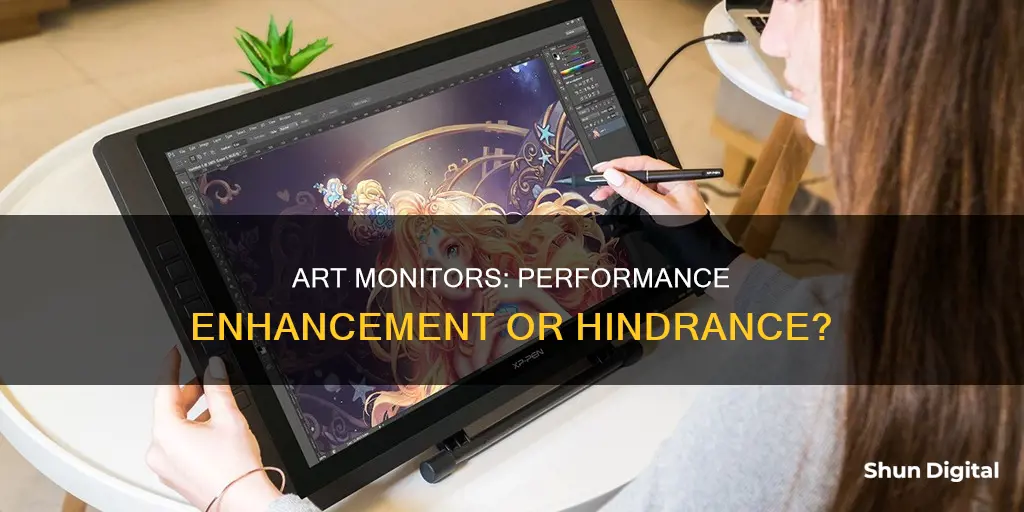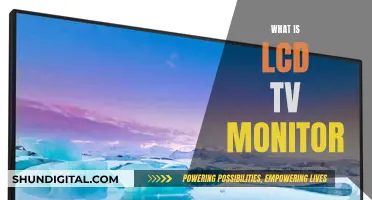
Art monitors are an essential tool for digital artists and designers, offering a range of benefits such as enhanced colour accuracy, resolution, and screen space. When choosing an art monitor, factors such as colour accuracy, resolution, display panel type, pixel density, and scaling should be considered to ensure the monitor meets the specific needs of the artist.
One of the most important considerations when selecting an art monitor is colour accuracy, which is crucial for artists, designers, and photographers. Artists should look for monitors with a low Delta-E value, preferably below 2, as this ensures accurate colour representation on the screen. Additionally, the number of colours a monitor can display is vital, with 8-bit and 10-bit monitors being suitable for general use and professional use, respectively.
In terms of resolution, artists should aim for 4K or 5K to balance detail and price. While a higher resolution provides more workspace and detail, it also demands more from the GPU. Display panel type is another key factor, with IPS panels typically offering superior colour accuracy and wider viewing angles compared to TN and VA panels.
Other considerations include pixel density, which affects image crispness, and scaling, which may be necessary to adjust the interface for comfortable viewing. Connectivity options, such as HDMI, DisplayPort, and USB-C, should also be compatible with the artist's machine.
Overall, when choosing an art monitor, it is essential to consider the specific needs of the artist, their budget, and the technical specifications of the monitor to ensure a balanced decision that enhances their creative work.
What You'll Learn

Dual monitors and their impact on gaming performance
Dual monitors generally do not have a significant impact on gaming performance, and modern advancements in graphics cards have made dual monitor setups a viable option for most users. However, there are a few factors to consider that can affect gaming performance when using dual monitors.
The first factor is the utilisation of the two screens. If you are running resource-intensive applications, such as demanding games or playing videos, on both screens simultaneously, it can exert additional strain on your computer, potentially leading to a noticeable slowdown. This is because your graphics card is now being tasked with rendering graphics for two monitors instead of one, which can result in a slight decrease in FPS (frames per second). The better your graphics card, the better your overall gaming performance will be, even with dual monitors.
Additionally, the specifications of your computer hardware play a crucial role. Upgrading your graphics card and processor can enhance your system's capabilities, reducing the impact of using dual monitors. Keeping your computer's software and drivers up to date can also optimise its performance and ensure compatibility with a dual monitor setup.
It is also important to ensure that both monitors have matching settings, such as resolution, colour settings, and refresh rate. This synchronisation minimises lag and creates a smooth, uninterrupted user experience.
Furthermore, closing unnecessary background programs or processes that may consume system resources can help improve performance when using dual monitors.
In summary, while dual monitors can consume more GPU resources, it typically does not have an adverse impact on gaming performance or FPS. However, if you are running resource-intensive applications on both screens, you may experience a slight decrease in performance, especially if your computer hardware does not meet the requirements for handling multiple screens efficiently.
Removing Grid Lines from Your Monitor: A Simple Guide
You may want to see also

The role of graphics cards in dual-monitor setups
Graphics cards play a crucial role in determining gaming performance in dual-monitor setups. They are responsible for processing and rendering images on both screens. Adding a second monitor increases the workload on the graphics card, especially when running resource-intensive applications or high resolutions. This can lead to a potential decrease in performance if the graphics card is already pushed to its limits.
The impact of a dual-monitor setup on performance depends on various factors, including the graphics card's capabilities, the applications being used, and the resolutions of the monitors. Modern graphics cards with sufficient processing power and VRAM can typically handle dual-monitor setups without significant performance degradation.
To optimize performance in a dual-monitor setup, consider the following:
- Ensure your graphics card supports multiple monitors. Dedicated video cards typically support dual monitors, while some built-in cards may also have this capability.
- Upgrade your graphics card if necessary to one with higher processing power and VRAM capacity.
- Adjust the settings of resource-intensive applications to allocate more resources to the primary screen, reducing the burden on the secondary monitor.
- Keep your graphics drivers up to date to ensure compatibility and optimal performance with a dual-monitor setup.
- Consider using features like GPU acceleration to offload some processing tasks from the CPU to the graphics card.
By following these strategies, you can enhance your multi-monitor setup's performance and enjoy the benefits of increased screen real estate without sacrificing gaming performance.
Delete Firefox Monitor: A Step-by-Step Guide to Removal
You may want to see also

How CPU utilisation is affected by multiple monitors
The utilisation of CPU is affected by multiple monitors, but the impact depends on various factors. The CPU processes various game-related tasks and sends instructions to the graphics card. While adding a second monitor may not significantly increase the load on the CPU, it is crucial to ensure that the CPU can handle the demands of gaming and any additional tasks on the second screen.
The graphics card plays a significant role in determining gaming performance. It processes and renders the images displayed on the monitors. Adding a second monitor may increase the workload on the graphics card, depending on the applications and resolutions used on both screens. Modern advancements in graphics cards have made dual-monitor setups a viable option for most users. These cards can process images at impressive speeds, reducing the impact on CPU utilisation.
However, running resource-intensive applications, such as demanding games or videos on both screens simultaneously, can strain the processing system and graphics cards. In such cases, they will work harder to support the activity across both displays, potentially leading to a noticeable slowdown. It is recommended to ensure that the computer's hardware meets or exceeds the requirements for handling multiple screens efficiently. Upgrading the graphics card and processor can enhance the system's capabilities and reduce the impact on CPU utilisation.
Additionally, keeping the computer's software and drivers up to date can optimise performance and ensure compatibility with a multi-monitor setup. Adjusting the settings of resource-intensive applications to allocate more resources to the primary screen can also lighten the burden on the secondary monitor.
Overall, while multiple monitors can affect CPU utilisation, the impact can be mitigated by ensuring the hardware is capable and taking steps to optimise performance, such as closing unnecessary background programs and updating drivers.
Uncover Hidden Android Trackers: Take Back Your Privacy
You may want to see also

The effect of display quality on computer performance
Display quality and size can have an impact on computer performance, and this is especially true when adding a second monitor to your setup.
The Impact of Display Quality on Computer Performance
The display quality on a computer can affect its performance in several ways. Firstly, the graphics card plays a crucial role in determining performance as it processes and renders the images displayed on the monitor. A higher display quality will increase the workload on the graphics card, which may impact the overall performance of the computer, especially if the GPU is already being pushed to its limits.
Additionally, the CPU and RAM can also be affected by display quality. The CPU sends instructions to the graphics card, and while a higher display quality may not significantly increase its load, it is important to ensure that the CPU can handle the demands of the display and any additional tasks. Similarly, RAM is necessary for smooth performance, and a higher display quality may increase its demand, especially with more applications running simultaneously.
The Impact of Display Size on Computer Performance
The size of a display can also impact computer performance. A multi-monitor setup, for example, will require the computer to work harder to maintain high display quality across all screens. This can lead to a noticeable slowdown, especially when running resource-intensive applications or games on multiple screens. However, with modern advancements in graphics cards, this impact on performance is generally minimal for most users.
Optimizing Performance
There are several ways to optimize computer performance when dealing with display quality and size:
- Ensure your computer's hardware meets or exceeds the requirements for handling the desired display quality and size.
- Adjust the settings of resource-intensive applications to allocate more resources to the primary screen, reducing the burden on the secondary display(s).
- Keep your computer's software and drivers up to date to optimize performance and ensure compatibility with your display setup.
- Close unnecessary background programs or processes that may consume system resources.
- Utilize features like GPU acceleration to offload some processing tasks to the graphics card, boosting overall performance.
- Ensure that both monitors have matching settings, such as resolution, color settings, and refresh rate, to minimize lag and create a smooth user experience.
In conclusion, while display quality and size can affect computer performance, with proper optimization and modern hardware, it is possible to maintain a smooth and enjoyable experience even with multiple high-quality displays.
Monitors: Choosing the Right Display for Your Needs
You may want to see also

The advantages of dual monitors for multitasking
Dual monitors can also improve peripheral awareness in competitive games, giving players an edge in detecting enemies outside their immediate field of view. This expanded perspective can provide a more immersive gaming experience.
Additionally, dual monitors can enhance streaming and content creation for gamers. Streamers can monitor broadcasting software, chat with viewers, and keep an eye on stream statistics, all while playing their game on the primary screen.
For those who are frequently travelling, portable dual monitors are a great option, providing the benefits of dual screens without compromising on space or setup complexity.
While dual monitors can increase the workload on your computer, with the right hardware and settings, any performance impact can be minimised.
Choosing the Right Monitor Size for Viewing 11x17 Plans
You may want to see also
Frequently asked questions
The impact of an art monitor on your computer's performance depends on various factors, including the specifications of your computer, the type of art monitor, and how you use it. In general, modern advancements in graphics cards have made it so that dual-monitor setups do not significantly affect performance.
When using an art monitor, consider the graphics card, CPU, RAM, resolution, texture quality, frame rate, and monitor refresh rate. Ensure your computer's hardware meets the requirements for handling multiple screens efficiently, and adjust settings to allocate resources effectively.
Yes, the type of art monitor can impact performance. For example, a higher resolution or refresh rate will demand more processing power from your graphics card. Additionally, certain features like USB-C charging or extensive ergonomics may put extra strain on your system.
To optimize performance, consider upgrading your graphics card, ensuring sufficient RAM and CPU capacity, and adjusting game or application settings to lower the graphics quality. Keep your software and drivers up to date, close unnecessary background programs, and optimize storage space.
Gamers should be aware that using a dual-monitor setup for an extended field of view (FOV) will increase the resolution and performance hit on the graphics card. Additionally, multitasking or opening apps on the second screen can affect gaming performance.







